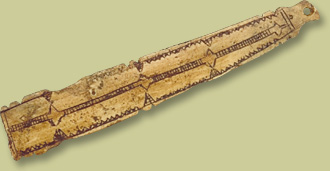|
|
Arrival of Strangers - The Last 500 YearsEarly RelationsPopulation and Identity - The BeothukBy 1830, all of the Beothuk were dead. They died out because of a combination of factors, including disease, population pressure, competition for resources, and conflicts with European, and perhaps Mi'kmaq newcomers. The Beothuk lived exclusively in Newfoundland. They first encountered European fishermen off the coast in the early 1500s. They stayed apart from the newcomers. But they made tools from the metal materials and objects they found at the Europeans' fish-processing plants. The Europeans saw this as theft. Because there were no formal relations between the two peoples, distrust became hostility. After numerous armed conflicts, the Beothuk retreated from the Europeans even more. But they returned to the vacant fishing camps for iron and copper. In the early 1700s, the Beothuk were competing directly with European colonists for food, and with Mi'kmaq families who had come in search of new fur sources. The few remaining Beothuk communities became openly hostile. They saw their oldest and youngest die from new diseases. By the end of the 1700s, clashes between the Beothuk and newcomers had become more violent. Colonizers had guns, and several Beothuk families and camps were massacred. The Beothuk retreated almost completely from Europeans, going so far as to punish their own people for fraternizing. They also vandalized fishing camps and private property, attempting to scare the Europeans away. Shanawdithit, captured in 1823, came to be known as the "last Beothuk". "You are doubtless aware that three of the Aborigines of this Island were brought to St. John's about two years ago, and two of them died very shortly after.... The third, a woman about 18 or 19 years of age is still alive.... She states that the whole number of her tribe did not exceed 15 persons in the winter of 1823, and that they were obliged by want of food to separate into three or four parties. Of these fifteen, two were shot down by some of our settlers, one was drowned, and three fell into our hands, so that only nine at the utmost remain to be accounted for." - R.A. Tucker, in James P. Howley, The Beothucks or Red Indians Some Beothuk artifacts are housed at the Newfoundland Museum, the British Museum, and the Canadian Museum of Civilization.
| |


